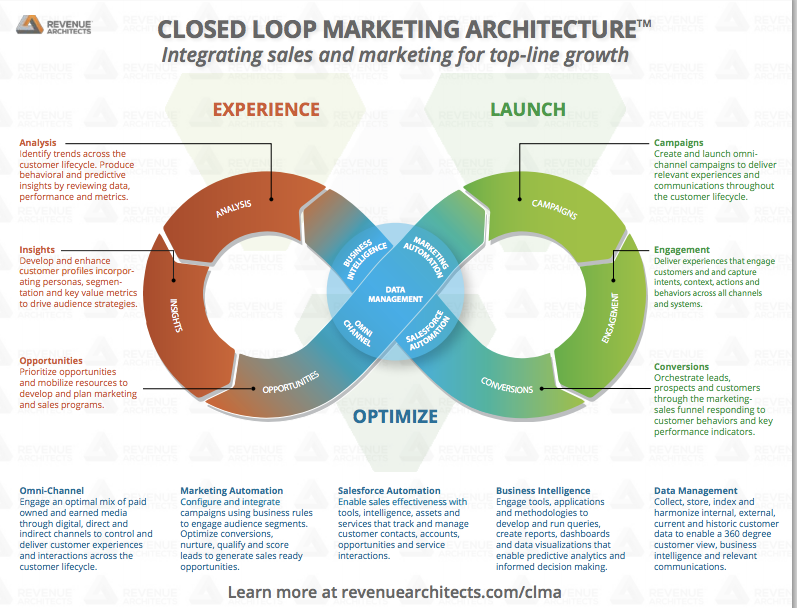A New Closed Loop Architecture for Integrated Marketing and Sales
The closed loop marketing architecture unifies and aligns sales and marketing teams around a single closed loop revenue process.
Today’s business buyers engage professional sales teams and “self-sell” on the web. The new revenue process requires inbound marketing as well as outbound sales engagement. Marketing, sales, and service must collaborate to optimize customer engagement, drive sales and capture customer value. Systems including omni-channels, marketing automation, data management and business intelligence are critical components of the process as insights about customer behaviors and preferences inform marketing campaigns and sales strategies.
Closed-loop Marketing Architecture
The diagram above describes three central elements of a closed loop marketing architecture. It follows a continuous three-step process:
Experience: understand and leverage customer insights and analytics to define a differentiated strategy and customer experience and align marketing and sales program.
Launch: integrate and launch campaigns, engaging technology and processes to deliver campaigns and build toward a 360-degree view of the customer
Optimize: engage your integrated technology platform and process to optimize campaigns that acquire customers, drive sales and optimize conversions.
A differentiated strategy, informed by customer insights, helps align sales and marketing teams to collaborate on customer engagement. These logically centralized systems inform marketing programs, and manage and track the life of the customer from audience to prospect to closed sale. A 360 degree view of the customer across all channels, preferences and behaviors helps to refine content marketing and lead conversion strategies as well as inform sales focus.
This closed loop marketing architecture also helps identify the ROI of sales marketing and strategies and determine which are working and not working. With better qualified leads and targeted programs, marketing and sales performance improves along with the the buyer experience.
Systems Involved
A closed loop marketing architecture connects five technology elements:
- Omni-channel – your direct, digital and media delivery channels
- Marketing Automation – systems to deliver integrated campaigns
- Sales force Automation – systems to manage contact relationships, account marketing and opportunities
- Business Intelligence – systems to engage data to build insights and define opportunities
- Data Management – systems to manage varied sources of data and augment data with toward a 360 degree view of the customer
Most businesses today rely on a range of data sources and systems to manage multiple activities and channels. A centralized electronic data warehouse (EDW) along with marketing data marts and business intelligence tools help mine data from various systems and develop deeper customer insights in order to create better programs, messages and content.
Websites and microsites serve as a marketing hub as traffic from multiple channels are funneled to the website for engagement and conversion. Search marketing programs, social media marketing, email, and offline activities help funnel visitors to websites and landing pages where you can capture leads. Data is captured across this omnichannel architecture.
Closing the Loop
As the diagram illustrates, modern revenue marketing and sales follows a continuous ‘infinite’ loop informed by data and intelligence to drive strategies and deliver programs that capture customer value.
We developed the CLMA – Closed Loop Marketing Architecture to help marketing and sales align around a continuous process for revenue growth. We will be updating the model on a regular basis. Download your copy here.



